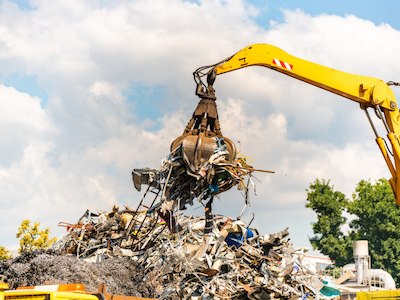Aluminum Scrap Markets

April 16, 2025
Tariffs, flat scrap and slippery LME
Written by Gabriella Vagnini
This week’s key takeaways:
- Aluminum pricing slips: Goldman Sachs slashes Q3 outlook to $2,000/mt. Some still see upside later this year, but volatility is rising.
- Scrap stays quiet: April pricing mostly flat for aluminum scrap. Exporters face continued freight pressure and soft overseas demand.
- China now faces up to 245% tariff on imports to the U.S.: That covers aluminum and derivative products unless explicitly exempted.
- A White House fact sheet indicates that 50-60% of U.S. made cars have foreign content: This makes tariffs a threat to aluminum sourcing in the auto sector.
- Home builders report rising costs for building materials due to tariffs: That includes aluminum used in housing construction.
- The World Trade Organization (WTO) slashed its global trade growth forecast: Citing “extra duties on steel and car imports” and global tariff escalation, both tied closely to aluminum industry flows and demand.
- Global automakers, like Hyundai, are absorbing cost impacts of tariffs: These include aluminum-intensive parts. But aluminum-heavy parts mean that relief won’t last if tariffs hold.
- The Stellantis plant closure in Windsor, Canada: Driven by 25% auto tariffs, also implies impacts on aluminum die-casting, structural, and extruded parts in North American auto supply chains.
- Sustainability push grows: Asia-Pacific demand for low-carbon aluminum surging, but U.S. readiness to meet that demand remains uncertain.
Tariffs reshape the market – Again
This week’s aluminum and scrap markets are a mixed bag, one part tariffs, one part pricing shifts, and a whole lot of questions about where things go from here.
The 25% tariff on all imported aluminum that went into effect is already sending shockwaves through the market. This time, there are no carve-outs, no exemptions for allies, no tariff-rate quotas, and no loopholes for downstream or lightly processed products.
The goal might be to bring production back home, but in the short run, it means higher costs, disrupted supply chains, and a bunch of companies scrambling to rework contracts. It’s also setting off the usual chain reaction. We’ve already seen the EU and Canada float retaliation measures. So while this might score political points, it’s going to put pressure on U.S. manufacturers that rely on imported inputs, especially in clean energy, autos, and packaging.
Aluminum Prices Take a Hit, But Outlook’s Still Divided
Goldman Sachs just cut their Q3 aluminum price forecast to $2,000/mt. They’re calling out oversupply and weaker global growth. But not everyone’s on the same page. Some analysts are still holding out hope for aluminum to outperform other base metals later this year, assuming smelters start cutting production or China ramps up stimulus.
Right now, LME prices have softened, lowering over $150/mt since April 1. The Midwest premium is heading in the other direction, as it’s on the rise, jumping $31/mt from April 1. What we are seeing is more volatility creeping in.
Scrap Market Feels Flat
In scrap, it’s been a wait-and-see month. Nonferrous, especially aluminum, hasn’t moved much. Most yards are calling it a flat April, maybe slightly down depending on the region. Secondary smelters are watching both supply and export flows closely, and a few are holding back on volumes until they get clearer direction from buyers.
Container freight hasn’t given anyone a break either. Costs remain sticky, and that’s putting pressure on exporters, especially in the Gulf and West Coast. Everyone’s bracing for a shake-up, it’s just not clear whether it’ll come from pricing, policy, or a shift in global flows.
Sustainability Still in the Spotlight
There’s a steady drumbeat growing louder on the sustainability front, especially across the Asia-Pacific region. Low-carbon aluminum demand keeps picking up, thanks to climate targets, EV buildouts, and pressure from buyers who want to clean up their supply chains. Markets are talking big numbers, saying this segment could top $60 billion in less than a decade.
That’s great on paper, but for U.S. producers and recyclers, it begs the question: are we actually positioned to meet that demand? While the talk around decarbonization continues, the U.S. is still dealing with outdated infrastructure, high energy costs, and inconsistent policy support. So even as the market points to “green aluminum” as the next big thing, the path to scaling it, especially in scrap and secondary, still looks murky from where we’re sitting.
Mark your calendars
| Data Release | Weekday | Date & Time (EST) | What It Tells Us | Why It Matters |
| U.S. leading economic indicators (LEI) | Monday | 4/21 – 10:00 AM | A forward looking composite of key indicators like new orders, jobless claims, and consumer expectations. | If it’s trending down, it could mean slower demand for durable goods, like autos, appliances, and construction, all key end-markets for aluminum and scrap. |
| Richmond Fed Manufacturing Index | Tuesday | 4/22 – 10:00 AM | Regional manufacturing activity in the Mid-Atlantic and Southeastern U.S. | A slowdown could suggest soft demand for extrusions, rolled products, and automotive components, especially among Tier 2/3 suppliers in that region. |
| S&P Global Flash U.S. Manufacturing PMI & Services PMI | Wednesday | 4/23 – 9:45 AM | Manufacturing provides a real-time read on factory output, order books, inventories, and input costs. Services shows how well the non-manufacturing sector (logistic, trade, etc…) is performing. | Rising PMIs suggest stronger demand for metal inputs; declining numbers can indicate a slowdown across sectors that consume aluminum, including packaging, aerospace, and transport. If services start to dip, freight and container shipping could get cheaper, potentially easing costs for scrap exporters. |
| New Home Sales | Wednesday | 4/23 – 10:00 AM | Reports how many newly built homes were sold, and at what price. | Construction is a big aluminum consumer (windows, siding, HVAC, etc..). Weak sales=slower demand for extrusions and rolled products. |
| Durable Goods | Thursday | 4/24 – 8:30 AM | It measures new orders for long-lasting products like machinery, vehicles, and appliances. | One of the most direct reads on downstream aluminum demand. If durable goods orders are down, it could mean less need for sheet, billet, castings, and scrap inputs. |
| Kaiser Aluminum Corp Q1 2025 Earnings | Thursday | 4/24 – 10:00 AM | Kaiser is a leading producer of semi-fabricated specialty aluminum products, serving aerospace, auto and industrial markets. | Their earnings will provide insights into demand trends in these sectors. |
| Federal Reserve Balance Sheet | Thursday | 4/24 – 4:30 PM | Tracks Feb holdings and credit programs. | Big changes here can influence interest rates and liquidity. If the Fed keeps tightening, financing costs rise, which can slow capex and inventory restocking for aluminum producers and service centers. |







